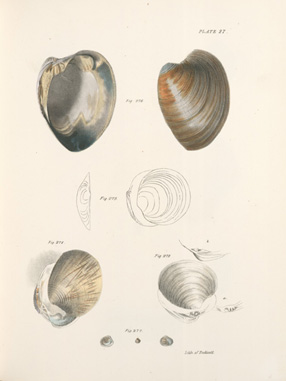

• Intro / Home
• Historical Neighbors
• Street and Backyard
Neighbors
• Park and Green Places
Neighbors
• Shore and Wetlands
Neighbors
• Salt and Freshwater
Neighbors
• Tiny Neighbors
• Unwelcome Neighbors
• Occasional and
Unexpected Neighbors
•
Wildlife Sighting Log
• Resources
• Hours and Tours
• Press Release
• NYPL HOME
| Historical Neighbors | |
The thick, strong shells of the widely abundant Quahog,
or Round, or Hard-shelled Clam were made into beads called wampum
by the native tribes of New Netherland. The purple part of the shell
yielded the more desirable darker beads, which, like the white beads,
were used both for ornament and as money by the Delaware Indians
and the early colonists. The Quahog’s scientific name, Mercenaria
mercenaria, doubly reflects its use as currency. The animal within has long been a favorite American
food item, whether eaten raw on the half-shell, incorporated into
clam chowder (with or without tomatoes), or prepared in some other
manner. Size designates it as a Littleneck, or Cherrystone, or Chowder
clam. Until the early 20th century, when polluted waters ended this
industry, New York City clams were widely exported to other American
cities. In recent years, as the city’s waters have become cleaner,
local clams have begun once again to be harvested and eaten, surreptitiously,
in defiance of local health laws. Included with the illustration of the Quahog in DeKay’s
landmark study of the fauna of New York State are several other
local mollusks, including the Gem Clam, Gemma gemma (bottom
figure), from the East River, and then known as "Venus gemma."
|
